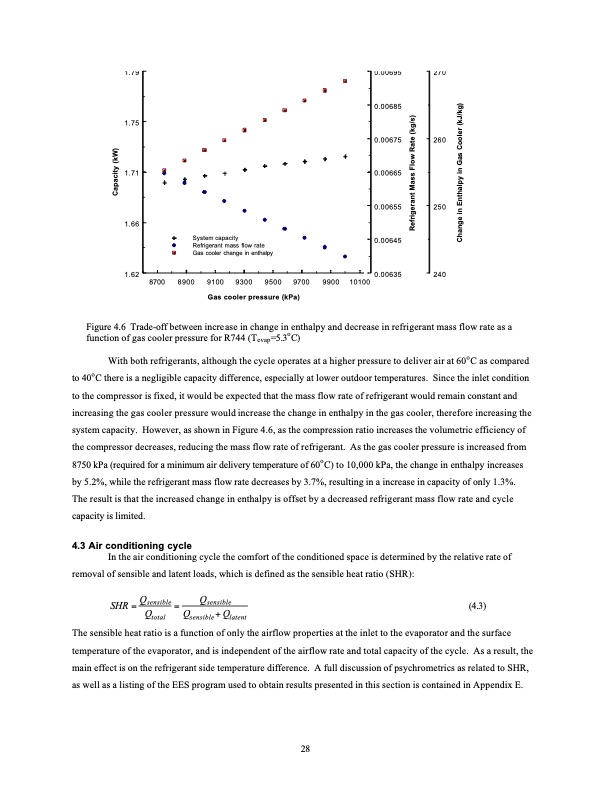
PDF Publication Title:
Text from PDF Page: 039
1.79 0.00695 270 1.75 1.71 1.66 1.62 8700 8900 9100 9300 9500 9700 9900 10100 0.00685 0.00675 260 0.00665 0.00655 250 0.00645 0.00635 240 System capacity Refrigerant mass flow rate Gas cooler change in enthalpy Gas cooler pressure (kPa) Figure 4.6 Trade-off between increase in change in enthalpy and decrease in refrigerant mass flow rate as a function of gas cooler pressure for R744 (Tevap=5.3oC) With both refrigerants, although the cycle operates at a higher pressure to deliver air at 60oC as compared to 40oC there is a negligible capacity difference, especially at lower outdoor temperatures. Since the inlet condition to the compressor is fixed, it would be expected that the mass flow rate of refrigerant would remain constant and increasing the gas cooler pressure would increase the change in enthalpy in the gas cooler, therefore increasing the system capacity. However, as shown in Figure 4.6, as the compression ratio increases the volumetric efficiency of the compressor decreases, reducing the mass flow rate of refrigerant. As the gas cooler pressure is increased from 8750 kPa (required for a minimum air delivery temperature of 60oC) to 10,000 kPa, the change in enthalpy increases by 5.2%, while the refrigerant mass flow rate decreases by 3.7%, resulting in a increase in capacity of only 1.3%. The result is that the increased change in enthalpy is offset by a decreased refrigerant mass flow rate and cycle capacity is limited. 4.3 Air conditioning cycle In the air conditioning cycle the comfort of the conditioned space is determined by the relative rate of removal of sensible and latent loads, which is defined as the sensible heat ratio (SHR): SHR = Qsensible = Qsensible (4.3) Qtotal Qsensible + Qlatent The sensible heat ratio is a function of only the airflow properties at the inlet to the evaporator and the surface temperature of the evaporator, and is independent of the airflow rate and total capacity of the cycle. As a result, the main effect is on the refrigerant side temperature difference. A full discussion of psychrometrics as related to SHR, as well as a listing of the EES program used to obtain results presented in this section is contained in Appendix E. 28 Capacity (kW) Refrigerant Mass Flow Rate (kg/s) Change in Enthalpy in Gas Cooler (kJ/kg)PDF Image | Comparison of R744 and R410A

PDF Search Title:
Comparison of R744 and R410AOriginal File Name Searched:
CR039.pdfDIY PDF Search: Google It | Yahoo | Bing
CO2 Organic Rankine Cycle Experimenter Platform The supercritical CO2 phase change system is both a heat pump and organic rankine cycle which can be used for those purposes and as a supercritical extractor for advanced subcritical and supercritical extraction technology. Uses include producing nanoparticles, precious metal CO2 extraction, lithium battery recycling, and other applications... More Info
Heat Pumps CO2 ORC Heat Pump System Platform More Info
| CONTACT TEL: 608-238-6001 Email: greg@infinityturbine.com | RSS | AMP |